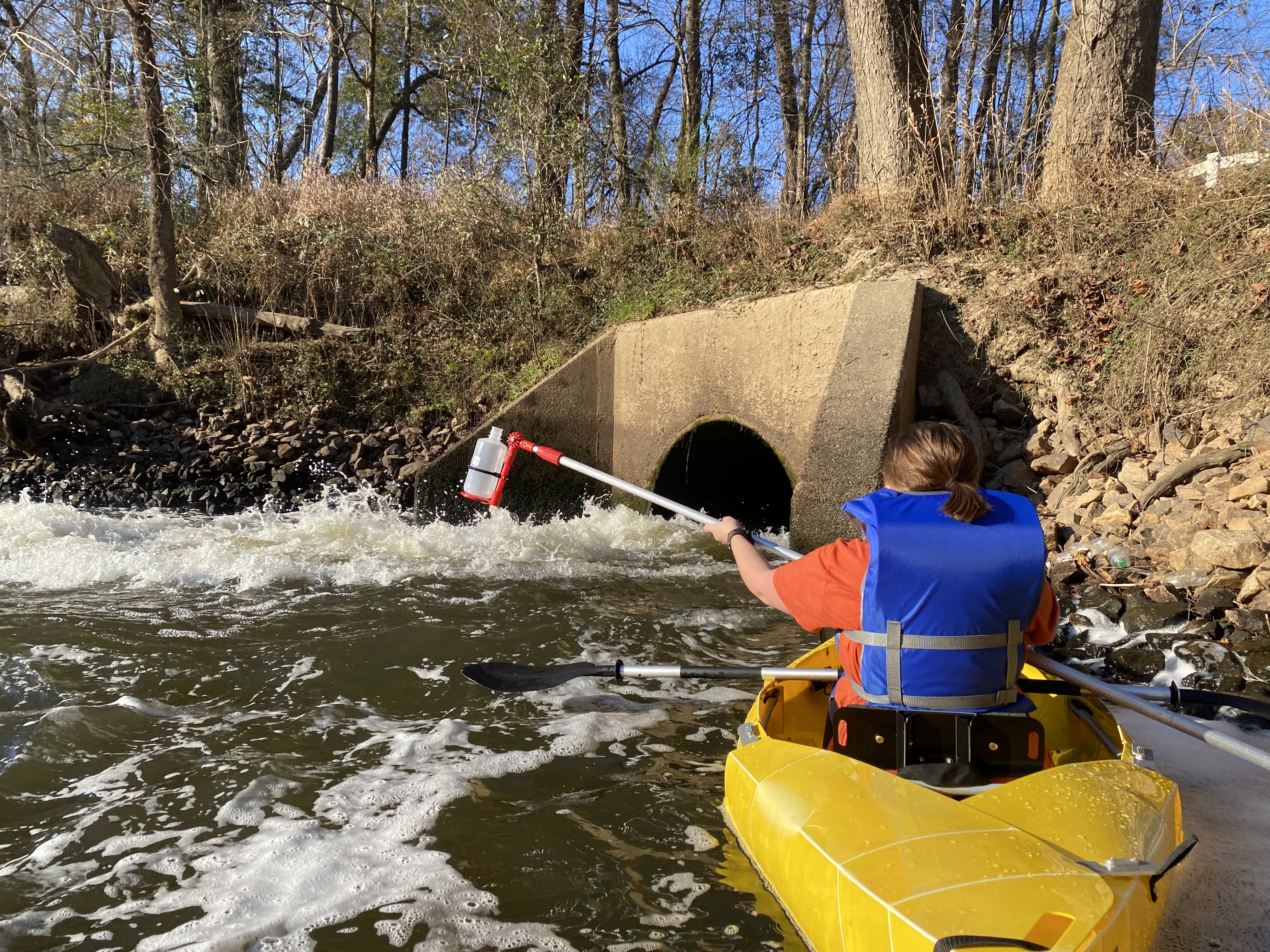The Hidden Afterlife of Antidepressants: How UNC’s Emily Crawford Tracks Drugs in North Carolina’s Waterways

As a member of Dr. Erin Baker's Lab, Emily Crawford is sampling water from five sites across central North Carolina—four near wastewater treatment plant outflows and one from a recreational lake that doesn’t receive wastewater effluent.

April 28, 2025 I By Dave DeFusco
In the UNC Chemistry Department, Ph.D. student Emily Crawford is staring down a mystery that most people never think about when they swallow a pill. Every day, millions of Americans rely on antidepressant medications to stabilize their moods and reclaim their lives. But once those drugs have done their job inside the human body, up to 90 percent of their chemical remnants—still biologically active—don’t just disappear. Instead, they pass quietly through wastewater treatment systems and into the rivers, lakes and streams that form the veins of our environment.
For Crawford, this intersection between mental health treatment and environmental chemistry is more than just an academic interest—it’s a passion project with global consequences. Recognized with an honorable mention from the National Science Foundation’s Graduate Research Fellowship Program, Crawford is pioneering a multidimensional approach to quantify antidepressants in North Carolina’s waterways and evaluate their molecular impacts on aquatic life.
Her findings could not only help clean up the water but also reframe how we think about the downstream effects—literally—of human health choices on the ecosystems we depend on. Crawford’s project was born out of a simple yet provocative question: what happens to antidepressants after they leave the human body?
“We know these drugs are essential for mental health,” she said. “But they’re also active in trace amounts, and our wastewater systems weren’t designed to catch them. So they persist in the environment—and fish and other aquatic species are exposed constantly.”
Antidepressants like sertraline and escitalopram—among the most widely prescribed SSRIs—have already been linked to behavioral and reproductive disruptions in aquatic organisms. Fish that become unusually bold or sluggish, or fail to reproduce on schedule may be responding to the same neurotransmitter-altering chemistry that helps people feel better. But until now, little has been known about how these exposures might be affecting organisms at a molecular level.
That’s where Crawford’s research breaks new ground. After graduating from Georgia Tech with a 4.0 GPA and a string of scholarships—including the Zell Miller and Women in Sciences Grant—Crawford headed to Chapel Hill to join the lab of analytical chemist Dr. Erin Baker, who said she was “ecstatic” to gain Crawford as a lab member.
“Emily has been an amazing addition to our lab,” said Dr. Baker. “She not only thinks deeply about scientific problems, but she has also driven this project by knowing the history of this area and finding unique strategies to address challenges that she has encountered in the lab. Emily is also an amazing mentor and teacher for our other students.”
Known for pioneering work in exposomics, Baker’s lab has built a strong reputation for studying so-called “forever chemicals” like PFAS. Crawford saw an opportunity to apply the lab’s sophisticated tools—particularly their liquid chromatography–ion mobility–mass spectrometry platform (LC-IMS-MS)—to something new: pharmaceuticals in the environment.
“I was really interested in how human behaviors interact with our environment and vice versa,” she said. “We realized that no one had ever used our specific platform to analyze antidepressants. That opened the door.”
The unique capabilities of the lab’s drift tube ion mobility spectrometer gave Crawford an edge. Unlike conventional mass spectrometry, which can struggle to distinguish molecules with identical masses, the drift tube adds another layer of separation—measuring molecules by their shape and gas-phase surface area, known as collision cross section (CCS). This allows for a level of structural resolution that’s vital when studying complex biological matrices like wastewater or fish tissue.
Before Crawford could analyze anything in the wild, she had to build a reference library from the ground up—a meticulous and time-consuming process that catalogued the key properties of 55 different antidepressant compounds and their metabolites, including SSRIs, SNRIs, MAOIs and tricyclics.
“It had never been done before on this platform,” she said. “These drugs are designed to break down in the body, and sometimes they were fragmenting in the instrument even when we didn’t want them to. It took a lot of optimization to keep them intact.”
She had another problem too: uncertainty. Would the pharmaceutical-grade standards she purchased from chemical suppliers be chemically identical to the forms showing up in real-world water samples? What about unknown degradation products?
“If those aren’t in the library,” she said, “we cannot identify them in the water samples with the same level of confidence. That’s one of the biggest challenges in environmental chemistry—what you don’t know can still hurt the ecosystem.”
With her library in place and methods validated, Crawford launched a two-part investigation.
In Aim 1, she is sampling water from five sites across central North Carolina—four near wastewater treatment plant outflows and one from a recreational lake that doesn’t receive wastewater effluent. She spikes each sample with “heavy” deuterated standards to enable precise quantification using her platform. Early data suggest a direct correlation between antidepressant concentrations and population size served by the plant, but the story is complicated by variables like water body size and flow rate.
In Aim 2, Crawford will travel to the University of Luxembourg to collaborate with environmental toxicologist Dr. Emma Schymanski. There, she’ll expose zebrafish embryos—model organisms often used in toxicology—to varying concentrations of antidepressants in a tightly controlled aquatic facility.
By analyzing lipid profiles from these embryos using her LC-IMS-MS platform, she hopes to determine whether antidepressants induce dyslipidemia—a disruption in fat metabolism known to be associated with cardiovascular issues in humans.
“There’s this longstanding controversy,” said Crawford. “Are side effects like dyslipidemia caused by the depression itself—through things like poor diet and sleep—or are they a direct result of the medication? With fish, we can control for those behaviors and isolate the effects of the drugs themselves.”
Her hypothesis: fish embryos exposed to high levels of antidepressants will show molecular changes—particularly in polyunsaturated fatty acids (PUFAs)—that correlate with previously observed behavioral disruptions. If confirmed, it would provide the first strong molecular evidence linking pharmaceutical pollution to ecosystem-wide health risks.
“With North Carolina’s growing population and diverse geography, it’s an ideal setting for this research,” she says. “But the issue is global. By partnering with labs in Europe and mentoring students here, I’m trying to make sure the science reaches beyond just one lab or one town.”

